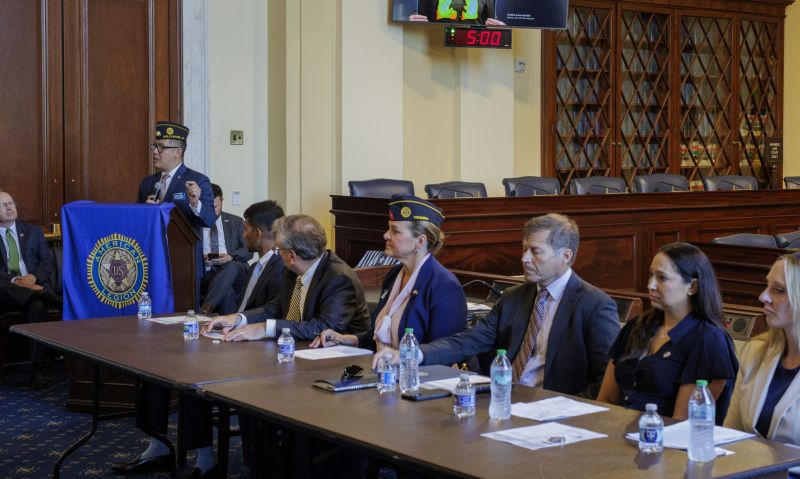
At American Legion panel discussion on law’s second anniversary, the widow of Heath Robinson, VA representative and others urge Congress to institute further changes to save veterans.
As the two-year anniversary of the PACT Act approaches, The American Legion held a panel discussion July 11 in the House Veterans’ Affairs Committee Room on Capitol Hill evaluating the impact of the far-reaching legislation while looking ahead to ensuring that it continues to serve veterans.
President Joe Biden’s signature of the bipartisan law — the Sgt. First Class Heath Robinson Honoring Our Promise to Address Comprehensive Toxins Act — ushered in the largest expansion of veterans benefits in a generation. The bill established a presumption of service connection for 23 respiratory illnesses and cancers related to burn pits, Agent Orange and other toxins.
More than 1 million PACT Act related claims have now been granted, and over 888,000 veterans and survivors are now receiving new service-connected disability benefits.
“That’s an impressive accomplishment, and everyone involved with the Veterans Affairs committees deserves credit,” Chanin Nuntavong, American Legion executive director for Government Affairs, said as he opened the special event. “But there is always more we can and must do to reach those still in need. Efforts are underway to efficiently triage veterans exposed to burn pits and experiencing symptoms. New and emerging FDA-approved technology can evaluate lung function more quickly and more cost effectively than traditional methods, and help streamline the process for those in need of medical care.”
A recurring topic during the panel discussion was encouraging the Department of Veterans Affairs (VA) and Congress to establish standardized screening programs and triaging workflow. American Legion Legislative Director Julia Mathis led the discussion, kicking it off with an update on the implementation by VA.
Retired Army Col. Steve Miska, executive director of the PACT Act for VA, explained that the department’s role is to work in collaboration with partners like The American Legion and screen as many veterans as possible. “We are very focused on the toxic exposure space,” he said. “We’re not going to stop until we get it right.”
Danielle Robinson, the widow of the PACT Act’s namesake, was among the panelists that offered their perspectives. Sgt. First Class Heath Robinson began fighting for his life 10 years after his deployment to Iraq in 2006. Originally, VA denied medical coverage to Heath, stating, “there was no connection between Heath's burn pit exposure and his lung cancer.”
The stage 4 lung cancer “obliterated” Heath’s lungs, Danielle recalled, referring to a term one of his doctor’s used.
“I don’t know how Heath was doing it — breathing — his last days with those lungs in his body,” she said, adding that when he was first diagnosed, he was running half marathons.
The initial advice from doctors missed the mark — your body’s changing since you are 30, your testosterone levels are off and others. Danielle stressed that their experience is precisely why the VA needs to incorporate such screening for all veterans who may be at risk.
“Imaging like this could have been very important to him because he went nine months without a cancer diagnosis,” she said. “So if this imaging would have been there for Heath to do — who knows? — he could have been here today. It’s the least we can do for our veterans today.”
Army veteran Cynthia Daniels, a Burn Pits 360 advocate, discussed having to leave her career as a Wilmington (Del.) police officer due to constrictive bronchiolitis, and autonomic nervous system illnesses, which developed from her exposure to burn pits and toxic exposure during her deployment during the Iraq War.
“All of a sudden, I would get short of breath just walking upstairs,” she explained. “During traffic stops, walking from one car to the other, I would have to stop and put my hand on one car, which wasn’t like me at all as an avid runner. I could not figure out what was wrong.”
Thankfully, a doctor diagnosed the condition but that underscores the need for all veterans to receive proper screening.
“I am very grateful for the PACT Act but more work needs to be done,” she said. “I am glad that we are talking about that here today.”
An issue that remains is how Congress and VA can increase the screening and ensure that care is accessible for even more veterans, especially those who live in rural areas.
Miska said options like virtual visits, mobile units and other means that bridge the distance are critical for those living long distances from VA medical centers. “Those are things that Congress can help us reach not just rural veterans but so that we can reach a lot of them.”
His top priority for Congress: help us get the word out.
“PACT has really helped us make some substantial changes not just how VA delivers care but how we function as an organization,” he said. “We’re doing things more jointly more than ever before.”
Robinson closed by saying the PACT Act “is very personal” and reiterated the call for additional action.
“Heath gave 110% into everything he did,” she said. “The PACT Act right now is just a start. We have a long way to go to know that they are being diagnosed properly, they’re being treated properly and Heath’s dying wish on his death bed was that we were going to get that done. He knew it was too late for him but he knew his brothers and sisters needed to be taken care of. So, I ask you all to give 110% into this PACT Act.”
- Veterans Healthcare

